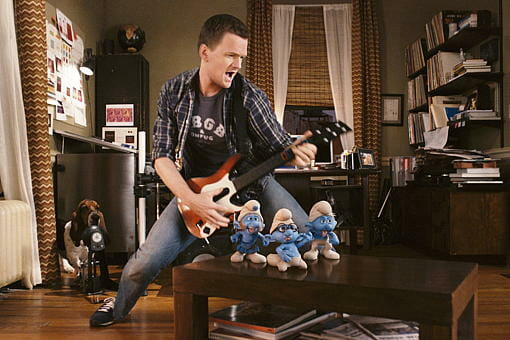By Sunny Choi · August 1, 2011

If you steal the basic premise of Enchanted, substitute a damsel-in-distress princess with adorable blue people, and cram even more repetitive chase scenes, you basically have The Smurfs. The fairy-tale protagonists in both movies interrupt busy people’s lives with song and dance and thwart evil wizards and witches in New York City. While trying to escape the evil wizard Gargamel (Hank Azaria), who seeks to extract the Smurf’s essence to accumulate more magical power, the Smurfs enter the blue moon portal and accidentally land themselves in the hustle and bustle of New York City. I would postulate that the audience consisted of two main groups–the adults (now parents with young children) who grew up watching the cartoon version and young children who enjoy light action-adventure cartoons. However, the movie may disappoint both audiences because of its departure from the original Smurfs and inappropriate humor and content for children.
Unfortunately, even from the beginning, it feels like the Smurfs in this movie have already lost their original essence. The only thing that reminds us that they’re the same Smurfs from the 80s is their theme song. As someone from the later era of Hey Arnold! and Rugrats, I can’t say this with complete certainty, but what seemed to distinguish the Smurfs from other kids cartoon characters was that each Smurf represented genuine, universally human sentiments and conditions. However, with the exception of Papa Smurf (Jonathan Winters) and the pitiful Clumsy (Anton Yelchin), the Smurfs in this film had flimsy character development. For example, since when does an Irish accent indicate that one is gutsy or that a gravelly voice mean that you are necessary grouchy? Moreover, the film falls back on gender stereotypes to depict Smurfette, the only female of the bunch, as the dress-loving, emotional wreck who was built to lure and trick male Smurfs (and illustrates a fairly chauvinistic view of women). Such carelessness in shaping the characters does a great disservice to the Smurfs’ enduring legacy and appeal.
Even departing further from their sweet and wholesome origins, the Smurfs just come off as self-entitled and irritating, especially as they constantly “sing the happy song” to force not only happiness upon us but also to acquire concessions from their human victims, Patrick and Grace Winslow (Neil Patrick Harris and Jayma Mays). This may send an inappropriate message to children–if you pester adults with your cuteness and charm, you’ll eventually get what you want.
Further detracting from sound quality development of the Smurfs, the film spends way too much time establishing that Gargamel is a disgusting, ridiculous villain who trips all over himself instead of developing each individual Smurf character. He sifts through cat barf to possess Smurfette’s (Katy Perry) lock of hair, briefly mistakes a portable toilet for a laboratory, and wrestles a water pitcher from a waiter in an upscale restaurant in order to urinate in it. Instead of incorporating age-appropriate, clean humor to appeal to a young audience, they misguidedly depended on gross scenes for a couple of cheap laughs. From occasional exhales of shock and disgust in the theater, I detected that some parents felt uncomfortable having their kids watch these slightly repulsive scenes. Considering what little substance he was given, Hank Azaria gave a compelling performance, disappearing into his role as the buck-toothed, balding, creepily evil wizard.
By excessively promoting mainstream pop culture, the film seemed to be trying to entice young children with the newest, “cool” products and subsequently pay homage to its sponsors. Tim Gunn from Project Runway, in his small cameo role, switched back and forth between his posh look of disdain and his catchphrase, “Make it work.” Katy Perry’s Smurfette unashamedly remarks, “I kissed a Smurf and I liked it!” These references just did not seem entertaining or appropriate enough for such a young audience. And when Patrick needs to blow off some steam, he decides to play one of the most commercially successful video games, Rock Band, and the Smurfs rap their theme song to a random heavy metal tune. By openly promoting different products, singers, and shows, the film suggests that young children must embrace certain merchandise in order to fit in and be “cool.” Selling out to commercial interests in such a manner brainwashes young children to accept all advertisements as legitimate and valid.
While the movie failed to impress, the interaction between Papa Smurf and Patrick helped reorient the film to engage its target audience: the family. Papa Smurf models the fatherly compassion and sacrifice, sagely wisdom, and unconditional love that Patrick eventually comes to respect and espouse. As a young married salary-man who has serious anxieties about his upcoming fatherhood, Patrick goes through the eventual transformation that most of these stock characters undergo; he must reevaluate his career-centered life and learn to actually consider those that support and love him. As in most cookie-cutter family adventure films, the protagonist comes to genuinely embrace his family and owes this sudden great insight to his new, fantastical friends. While not an original ending, it remains one of the few occasions in which the film emits a positive message to its young audience: to love and appreciate your family and friends, especially when life gets hectic and complicated.
Even though this movie features some good acting and relatively good CGI, it drastically falls short of the ideal summer kids’ blockbuster perhaps because it tries overly hard to satisfy its commercial interests and draw quick, easy laughs. In doing so, it fails to stay true to the essence of the characters and the original television series. Perhaps this reflects our generation’s growing distance from the Smurfs and an increasing affinity towards a more risqué-type of humor and cartoons. However, that is disappointing, as this film may have been a good opportunity to introduce such a beloved classic cartoon to the younger generation.